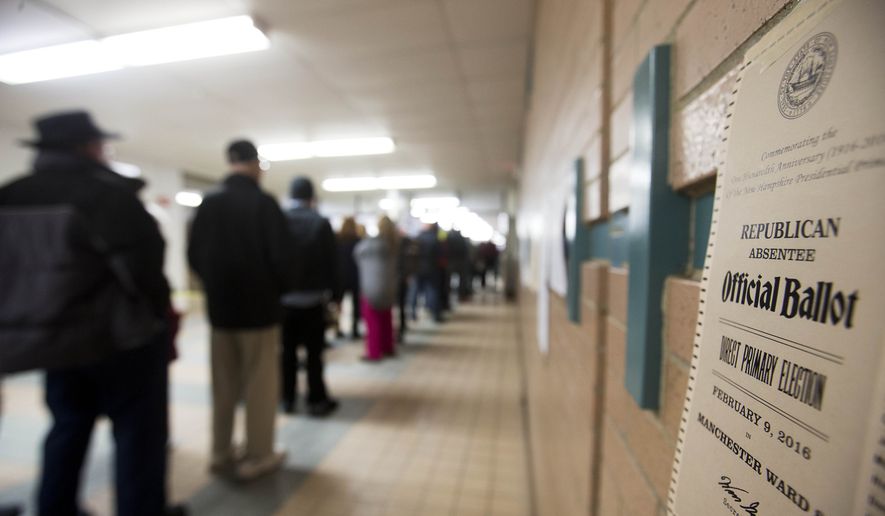Republicans shattered their party’s New Hampshire turnout record in Tuesday’s primary and came within a whisker of matching Democrats’ 2008 performance, signaling intense energy among GOP voters this year.
Powered by Donald Trump and a crowded field, Republicans drew nearly 285,000 voters to the polls, which was 15 percent more than in 2012, and just shy of the all-time record of 287,000 voters that Democrats drew in their marquee 2008 battle.
By contrast, Democrats drew slightly more than 250,000 voters in New Hampshire this year — a strong showing, but substantially shy of what the GOP did.
Combined, the two parties set a new overall record for turnout.
“GOP turnout in New Hampshire was impressive. The primary attracted record numbers and shows lots of voter engagement in the process,” said Darrell M. West, director of governance studies at the Brookings Institution. “Democrats were below their 2008 numbers, but they also attracted healthy participation. The numbers in each party indicate there is lots of voter interest in the election and that the fall likely is to be a high-turnout election.”
Exit polling found that about 15 percent of voters in each primary said they were first-time voters — and the two iconoclastic candidates, Sen. Bernard Sanders on the Democratic side and businessman Donald Trump on the Republican side, each claimed the biggest share of those first-timers.
The New Hampshire results follow last week’s Iowa caucus turnout, where Republicans easily outdistanced Democrats by more than 50 percent.
Democrats, though, say they’re still happy with their turnout, saying that on a per-candidate basis they did just fine, since there were only Mrs. Clinton and Sen. Bernard Sanders to draw voters on their side, compared to eight major GOP candidates.
“In Iowa our two candidates, along with Martin O’Malley, turned out 171,000 caucus-goers, compared to the ELEVEN Republican candidates — who ended up virtually in the same spot at 180,000,” Democratic National Committee Chairman Luis Miranda said in a memo after Tuesday’s voting. “We saw that same kind of enthusiasm in New Hampshire.”
Michael P. McDonald, a University of Florida professor who studies turnout, said the high number of candidates is definitely a factor in the GOP’s turnout.
“What’s driving turnout right now is we have competitive races,” he said. “In particular I would say on the Republican side the election is more competitive because you have more candidates, and those candidates, it’s meaningful to voters not just who wins but also who comes in second and third, so there’s a lot more interest on that side of the ledger.”
Mr. McDonald said New Hampshire and Iowa, which kick off the primary season, get months of attention from candidates and that makes them high-turnout in their caucuses and primaries. States later in the calendar, though, see a substantial drop-off, as candidates have to spread their attention out, and don’t have the money to invest in an intense turnout operation.
SEE ALSO: Hillary Clinton leans on minorities to revive campaign
He said that could be a particular challenge for Mr. Trump who on the one hand has very enthusiastic supporters, but those backers are drawn heavily from among less-educated voters, who tend to turn out at lower rates.
“He really inflames passions, but at the same time he inflames passions among a segment of the electorate that’s erratic when it comes to voter turnout,” Mr. McDonald said.
The professor also cautioned against reading too much into the GOP’s numbers versus Democrats at this point, saying that in 2000 Republicans drew far more voters in the Iowa caucuses but the general election ended up being very close.
“I wouldn’t put a lot of weight on saying either side would be advantaged in the general election,” Mr. McDonald said.
• Stephen Dinan can be reached at sdinan@washingtontimes.com.




Please read our comment policy before commenting.